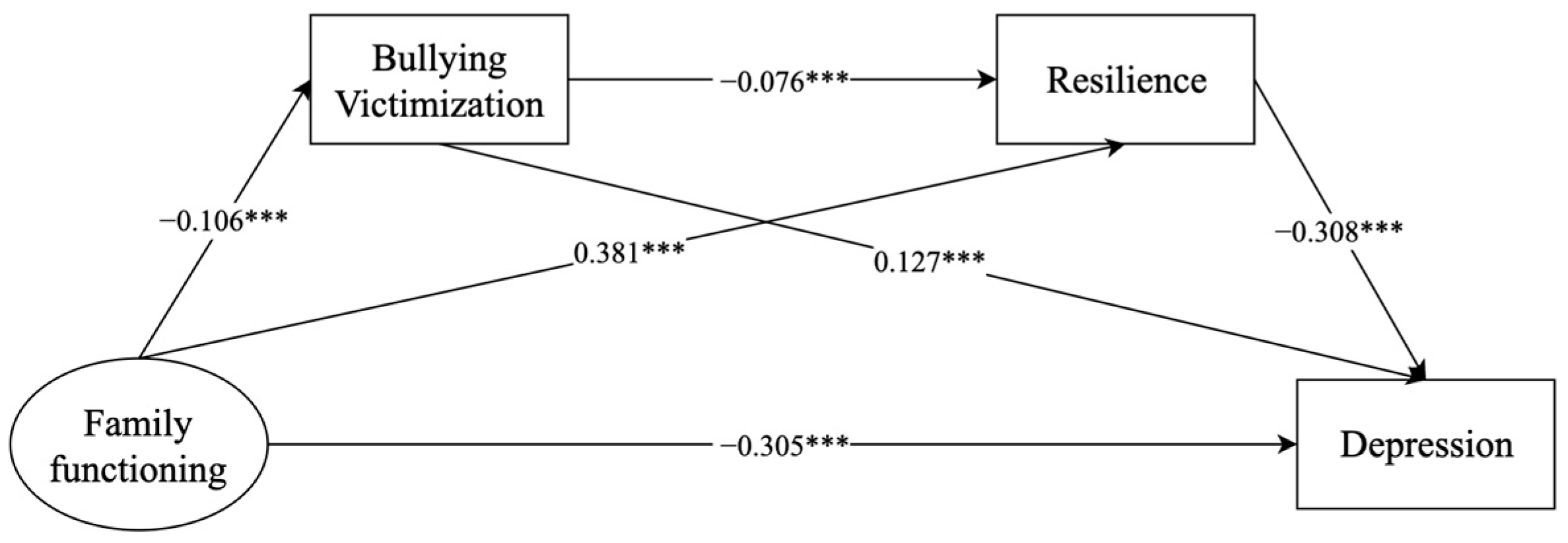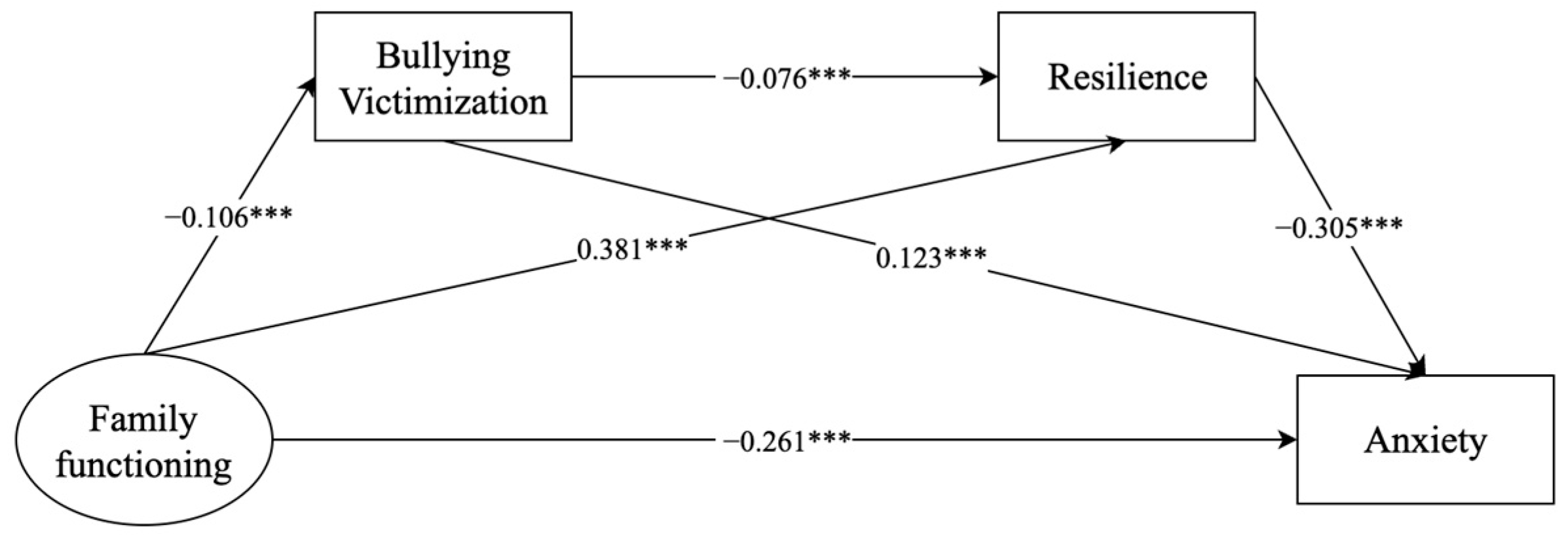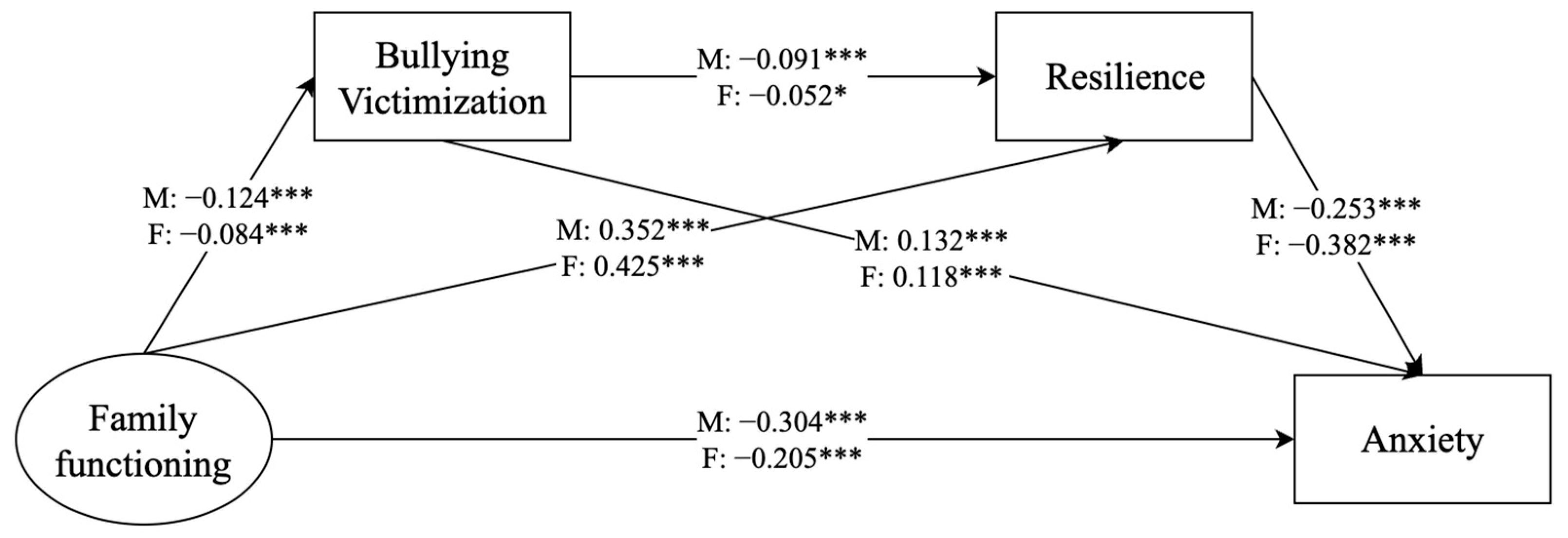Family Functioning and Adolescent Mental Health: The Mediating Role of Bullying Victimization and Resilience
Abstract
1. Introduction
1.1. The Influence of Family Functioning on Mental Health
1.2. The Mediating Role of Bullying Victimization
1.3. The Mediating Role of Resilience
1.4. The Current Study
2. Methods
2.1. Data and Sample
2.2. Measurements
2.2.1. Sociodemographic Information
2.2.2. Family Functioning
2.2.3. Bullying Victimization
2.2.4. Resilience
2.2.5. Depression
2.2.6. Anxiety
2.3. Data Analysis
3. Results
3.1. Common Method Bias
3.2. Descriptive Statistics
3.3. Correlation Analyses
3.4. Mediation Analyses
3.4.1. Family Functioning and Depression
3.4.2. Family Functioning and Anxiety
3.4.3. Gender Differences
4. Discussion
4.1. Depression and Anxiety in Adolescents
4.2. Family Functioning and Adolescent Mental Health
4.3. The Mediating Role of Bullying Victimization and Resilience
4.4. Gender Differences
4.5. Limitations
5. Conclusions
Author Contributions
Funding
Institutional Review Board Statement
Informed Consent Statement
Data Availability Statement
Conflicts of Interest
References
- Bor, W.; Dean, A.J.; Najman, J.; Hayatbakhsh, R. Are child and adolescent mental health problems increasing in the 21st century? A systematic review. Aust. N. Z. J. Psychiatry 2014, 48, 606–616. [Google Scholar] [CrossRef] [PubMed]
- Collier, C. Adolescent mental health: Interna. CMAJ 2012, 184. [Google Scholar]
- Chen, J.; Liao, W. Childhood non-contact corporal punishment revealed in the questionnaire survey of technical secondary school students. Chin. Ment. Health J. 2005, 19, 243–246. [Google Scholar]
- Ma, L.; Mazidi, M.; Li, K.; Li, Y.; Chen, S.; Kirwan, R.; Zhou, H.; Yan, N.; Rahman, A.; Wang, W. Prevalence of mental health problems among children and adolescents during the COVID-19 pandemic: A systematic review and meta-analysis. J. Affect. Disord. 2021, 293, 78–89. [Google Scholar] [CrossRef] [PubMed]
- Bisson, K.H. The Effect of Anxiety and Depression on College Students’ Academic Performance: Exploring Social Support as a Moderator. Master’s Thesis, Abilene Christian University, Abilene, TX, USA, 2017. [Google Scholar]
- Bauer, M.E.; Teixeira, A.L. Neuroinflammation in mood disorders: Role of regulatory immune cells. Neuroimmunomodulation 2021, 28, 99–107. [Google Scholar] [CrossRef] [PubMed]
- Bronfenbrenner, U.; Ceci, S.J. Nature-nuture reconceptualized in developmental perspective: A bioecological model. Psychol. Rev. 1994, 101, 568. [Google Scholar] [CrossRef] [PubMed]
- Steinberg, L.; Morris, A.S. Adolescent development. Annu. Rev. Psychol. 2001, 52, 83–110. [Google Scholar] [CrossRef] [PubMed]
- Cook, W.L.; Kenny, D.A. Examining the validity of self-report assessments of family functioning: A question of the level of analysis. J. Fam. Psychol. 2006, 20, 209. [Google Scholar] [CrossRef]
- Qiankun, H.; Shengli, T. Effects of family function and stress feeling on the mental health of adolescents. Chin. J. Child Health Care 2022, 30, 1380–1384. [Google Scholar]
- Tamplin, A.; Goodyer, I.M.; Herbert, J. Family functioning and parent general health in families of adolescents with major depressive disorder. J. Affect. Disord. 1998, 48, 1–13. [Google Scholar] [CrossRef]
- Oltean, I.I.; Perlman, C.; Meyer, S.; Ferro, M.A. Child mental illness and mental health service use: Role of family functioning (family functioning and child mental health). J. Child Fam. Stud. 2020, 29, 2602–2613. [Google Scholar] [CrossRef]
- Tamplin, A.; Gooyer, I. Family functioning in adolescents at high and low risk for major depressive disorder. Eur. Child Adolesc. Psychiatry 2001, 10, 170–179. [Google Scholar] [CrossRef] [PubMed]
- Bögels, S.M.; Brechman-Toussaint, M.L. Family issues in child anxiety: Attachment, family functioning, parental rearing and beliefs. Clin. Psychol. Rev. 2006, 26, 834–856. [Google Scholar] [CrossRef] [PubMed]
- Olweus, D. Bully/victim problems among schoolchildren: Long-term consequences and an effective intervention program. In Mental Disorder and Crime; Sage Publications: Thousand Oaks, CA, USA, 1993. [Google Scholar]
- Stevens, V.; De Bourdeaudhuij, I.; Van Oost, P. Relationship of the family environment to children’s involvement in bully/victim problems at school. J. Youth Adolesc. 2002, 31, 419–428. [Google Scholar] [CrossRef]
- Zych, I.; Farrington, D.P.; Ttofi, M.M. Protective factors against bullying and cyberbullying: A systematic review of meta-analyses. Aggress. Violent Behav. 2019, 45, 4–19. [Google Scholar] [CrossRef]
- Eşkisu, M. The relationship between bullying, family functions, perceived social support among high school students. Procedia-Soc. Behav. Sci. 2014, 159, 492–496. [Google Scholar] [CrossRef]
- Chen, J.-K.; Wang, S.-C.; Chen, Y.-W.; Huang, T.-H. Family climate, social relationships with peers and teachers at school, and school bullying victimization among third grade students in elementary schools in Taiwan. Sch. Ment. Health 2021, 13, 452–461. [Google Scholar] [CrossRef]
- Källmén, H.; Hallgren, M. Bullying at school and mental health problems among adolescents: A repeated cross-sectional study. Child Adolesc. Psychiatry Ment. Health 2021, 15, 1–7. [Google Scholar] [CrossRef] [PubMed]
- Masood, N.; Okazaki, S.; Takeuchi, D.T. Gender, family, and community correlates of mental health in South Asian Americans. Cult. Divers. Ethn. Minor. Psychol. 2009, 15, 265. [Google Scholar] [CrossRef]
- Kim, Y.K.; Kim, Y.J.; Maleku, A.; Moon, S.S. Typologies of peer victimization, depression, and alcohol use among high school youth in the United States: Measuring gender differences. Soc. Work Public Health 2019, 34, 293–306. [Google Scholar] [CrossRef]
- Bolier, L.; Haverman, M.; Westerhof, G.J.; Riper, H.; Smit, F.; Bohlmeijer, E. Positive psychology interventions: A meta-analysis of randomized controlled studies. BMC Public Health 2013, 13, 1–20. [Google Scholar] [CrossRef] [PubMed]
- Dou, D.; Shek, D.T.; Tan, L.; Zhao, L. Family functioning and resilience in children in mainland China: Life satisfaction as a mediator. Front. Psychol. 2023, 14, 1175934. [Google Scholar] [CrossRef] [PubMed]
- Davydov, D.M.; Stewart, R.; Ritchie, K.; Chaudieu, I. Resilience and mental health. Clin. Psychol. Rev. 2010, 30, 479–495. [Google Scholar] [CrossRef] [PubMed]
- Nam, B.; Kim, J.Y.; DeVylder, J.E.; Song, A. Family functioning, resilience, and depression among North Korean refugees. Psychiatry Res. 2016, 245, 451–457. [Google Scholar] [CrossRef] [PubMed]
- Anderson, J.R.; Mayes, T.L.; Fuller, A.; Hughes, J.L.; Minhajuddin, A.; Trivedi, M.H. Experiencing bullying’s impact on adolescent depression and anxiety: Mediating role of adolescent resilience. J. Affect. Disord. 2022, 310, 477–483. [Google Scholar] [CrossRef] [PubMed]
- Weitkamp, K.; Seiffge-Krenke, I. The association between parental rearing dimensions and adolescent psychopathology: A cross-cultural study. J. Youth Adolesc. 2019, 48, 469–483. [Google Scholar] [CrossRef] [PubMed]
- Lin, L.-Y.; Chien, Y.-N.; Chen, Y.-H.; Wu, C.-Y.; Chiou, H.-Y. Bullying experiences, depression, and the moderating role of resilience among adolescents. Front. Public Health 2022, 10, 872100. [Google Scholar] [CrossRef] [PubMed]
- Chang, F.C.; Lee, C.M.; Chiu, C.H.; Hsi, W.Y.; Huang, T.F.; Pan, Y.C. Relationships among cyberbullying, school bullying, and mental health in Taiwanese adolescents. J. Sch. Health 2013, 83, 454–462. [Google Scholar] [CrossRef] [PubMed]
- Katz-Wise, S.L.; Sarda, V.; Line, E.C.; Marchwinski, B.; Budge, S.L.; Godwin, E.G.; Moore, L.; Ehrensaft, D.; Rosal, M.C.; Thomson, K.A. Longitudinal Family Functioning and Mental Health in Transgender and Nonbinary Youth and Their Families. J. Child Fam. Stud. 2024, 33, 1321–1335. [Google Scholar] [CrossRef]
- Xu, M.; Wu, Q.; Zhu, H. Research on the emotional balance, resilience and mental health of adolescents during the epidemic. In Proceedings of the 2nd International Conference on Computer Vision, Image, and Deep Learning, Liuzhou, China, 25–27 June 2021; pp. 376–380. [Google Scholar]
- Smilkstein, G. The family APGAR: A proposal for a family function test and its use by physicians. J. Fam. Pract. 1978, 6, 1231–1239. [Google Scholar]
- Lv, F.; Gu, Y. Family APGAR questionnaire and its clinical application. Handb. Hosp. Manag. 1995, 2, 56–59. [Google Scholar]
- Zhang, W.; Wu, J.; Jones, K. Revision of the Chinese version of olweus child bullying questionnaire. Psychol. Dev. Educ. 1999, 2, 7–11. [Google Scholar]
- Campbell-Sills, L.; Stein, M.B. Psychometric analysis and refinement of the connor–davidson resilience scale (CD-RISC): Validation of a 10-item measure of resilience. J. Trauma. Stress Off. Publ. Int. Soc. Trauma. Stress Stud. 2007, 20, 1019–1028. [Google Scholar] [CrossRef] [PubMed]
- Cheng, C.; Dong, D.; He, J.; Zhong, X.; Yao, S. Psychometric properties of the 10-item Connor–Davidson Resilience Scale (CD-RISC-10) in Chinese undergraduates and depressive patients. J. Affect. Disord. 2020, 261, 211–220. [Google Scholar] [CrossRef] [PubMed]
- Kroenke, K.; Spitzer, R.L.; Williams, J.B. The PHQ-9: Validity of a brief depression severity measure. J. Gen. Intern. Med. 2001, 16, 606–613. [Google Scholar] [CrossRef] [PubMed]
- Min, B.-q.; Zhou, A.-h.; Liang, F.; Jia, J. Clinical application of Patient Health Questionnaire for self-administered measurement (PHQ-9) as screening tool for depression. J. Neurosci. Ment. Health 2013, 13, 569–572. [Google Scholar]
- Spitzer, R.L.; Kroenke, K.; Williams, J.B.; Löwe, B. A brief measure for assessing generalized anxiety disorder: The GAD-7. Arch. Intern. Med. 2006, 166, 1092–1097. [Google Scholar] [CrossRef]
- Moss, S. Fit indices for structural equation modeling. Front. Psychol. 2009, 12, 783226. [Google Scholar]
- Marsh, H.W.; Hau, K.-T.; Wen, Z. In search of golden rules: Comment on hypothesis-testing approaches to setting cutoff values for fit indexes and dangers in overgeneralizing Hu and Bentler’s (1999) findings. Struct. Equ. Model. 2004, 11, 320–341. [Google Scholar] [CrossRef]
- Fuller, C.M.; Simmering, M.J.; Atinc, G.; Atinc, Y.; Babin, B.J. Common methods variance detection in business research. J. Bus. Res. 2016, 69, 3192–3198. [Google Scholar] [CrossRef]
- Huang, X.-X.; Li, Y.-T.; Chen, J.-H.; Ma, J.-J.; Cong, E.-Z.; Xu, Y.-F. The influence of family structure on depression and anxiety symptoms in adolescents: The mediating role of emotional neglect. Zhongguo Dang Dai Er Ke Za Zhi Chin. J. Contemp. Pediatr. 2023, 25, 80–85. [Google Scholar]
- Liu, S.; Chen, X.; Li, Y.; Yuan, X.; Yu, H.; Fang, M. Investigation of depression and anxiety and their influencing factors among adolescents in Beijing during the coronavirus disease 2019 epidemic. J. Cap. Med. Univ. 2021, 42, 412. [Google Scholar]
- Buli, B.; Larm, P.; Nilsson, K.; Giannotta, F. Trends in adolescent mental health problems: Differences by SES and gender. Eur. J. Public Health 2021, 31, ckab164-307. [Google Scholar] [CrossRef]
- Knowles, G.; Gayer-Anderson, C.; Beards, S.; Blakey, R.; Davis, S.; Lowis, K.; Stanyon, D.; Ofori, A.; Turner, A.; Pinfold, V. Mental distress among young people in inner cities: The Resilience, Ethnicity and AdolesCent Mental Health (REACH) study. J. Epidemiol. Community Health 2021, 75, 515–522. [Google Scholar] [CrossRef]
- Xu, J.; Fang, X.; Zhang, J.; Lin, D.; Sun, L. Effect mechanism of family functioning on adolescent’s emotional problem. Psychol. Dev. Educ. 2008, 24, 79–85. [Google Scholar]
- Chen, B.; Wang, W.; Yang, S. The impact of family functioning on depression in college students: A moderated mediation model. J. Affect. Disord. 2023, 340, 448–455. [Google Scholar] [CrossRef] [PubMed]
- Jing, H.; Hui-chang, C.; Xin-yin, C. The prediction of Behavioral Inhibition of the Children from Two to Seven Years Old for Problem Behavior and School Adjustment. Psychol. Dev. Educ. 2009, 2, 13–20. [Google Scholar]
- FletcherD, S. Psychologicalresilience: Areviewand critiqueofdefinitions, concepts, andtheory. Eur. Psychol. 2013, 18, 12–23. [Google Scholar]
- Husky, M.M.; Delbasty, E.; Bitfoi, A.; Carta, M.G.; Goelitz, D.; Koç, C.; Lesinskiene, S.; Mihova, Z.; Otten, R.; Kovess-Masfety, V. Bullying involvement and self-reported mental health in elementary school children across Europe. Child Abus. Negl. 2020, 107, 104601. [Google Scholar] [CrossRef]
- Arseneault, L.; Bowes, L.; Shakoor, S. Bullying victimization in youths and mental health problems:‘Much ado about nothing’? Psychol. Med. 2010, 40, 717–729. [Google Scholar] [CrossRef]
- Fletcher, D.; Sarkar, M. A grounded theory of psychological resilience in Olympic champions. Psychol. Sport Exerc. 2012, 13, 669–678. [Google Scholar] [CrossRef]
- Walsh, F. Family resilience: A framework for clinical practice. Fam. Process 2003, 42, 1–18. [Google Scholar] [CrossRef] [PubMed]
- Silva-Rocha, N.; Soares, S.; Brochado, S.; Fraga, S. Bullying involvement, family background, school life, and well-being feelings among adolescents. J. Public Health 2020, 28, 481–489. [Google Scholar] [CrossRef]
- Nuñez-Fadda, S.M.; Castro-Castañeda, R.; Vargas-Jiménez, E.; Musitu-Ochoa, G.; Callejas-Jerónimo, J.E. Impact of bullying—Victimization and gender over psychological distress, suicidal ideation, and family functioning of mexican adolescents. Children 2022, 9, 747. [Google Scholar] [CrossRef]
- Bibi, A.; Lin, M.; Brailovskaia, J.; Margraf, J. Mental health of university students of Pakistan and Germany and the right to health care. Int. J. Hum. Rights Healthc. 2023. [Google Scholar] [CrossRef]




| Variables | n (%) | Depression | Anxiety |
|---|---|---|---|
| Gender | |||
| Male | 2347 (54.3) | 4.41 ± 5.15 | 4.04 ± 4.65 |
| Female | 1972 (45.7) | 5.64 ± 5.31 | 5.53 ± 4.72 |
| t | −7.681 | −10.399 | |
| p | <0.001 | <0.001 | |
| Grade | |||
| First-year senior | 1987 (46.0) | 5.24 ± 5.14 | 5.09 ± 4.93 |
| Second-year senior | 1663 (38.5) | 4.64 ± 5.16 | 4.32 ± 4.55 |
| Third-year senior | 669 (15.5) | 5.01 ± 5.00 | 4.59 ± 4.53 |
| F | 5.889 | 12.231 | |
| p | <0.01 | <0.001 | |
| One-child family | |||
| Yes | 2732 (63.3) | 4.89 ± 5.29 | 4.67 ± 4.80 |
| No | 1587 (36.7) | 5.12 ± 5.20 | 4.80 ± 4.63 |
| t | −1.392 | −0.919 | |
| p | >0.05 | >0.05 | |
| Family economy | |||
| Good | 1207 (27.9) | 4.20 ± 4.77 | 4.29 ± 4.64 |
| General | 2804 (64.9) | 5.02 ± 5.16 | 4.70 ± 4.58 |
| Poor | 308 (7.1) | 7.61 ± 6.86 | 6.59 ± 5.95 |
| F | 37.499 | 20.232 | |
| p | <0.001 | <0.001 | |
| Bullying victimization | |||
| Yes | 271 (6.3) | 8.71 ± 6.57 | 7.85 ± 5.83 |
| No | 4048 (93.7) | 4.72 ± 5.06 | 4.51 ± 4.58 |
| t | −9.806 | −9.241 | |
| p | <0.001 | <0.001 |
| 1 | 2 | 3 | 4 | 5 | |
|---|---|---|---|---|---|
| 1. Family functioning | |||||
| 2. Bullying victimization | −0.100 ** | ||||
| 3. Resilience | 0.394 ** | −0.106 ** | |||
| 4. Depression | −0.431 ** | 0.184 ** | −0.459 ** | ||
| 5. Anxiety | −0.382 ** | 0.171 ** | −0.439 ** | 0.794 ** |
| Effects | Estimate | S.E. | 95% CI | p-Value | |
|---|---|---|---|---|---|
| Lower | Upper | ||||
| Direct effect | |||||
| Family functioning → Depression | −0.305 | 0.017 | −0.338 | −0.272 | <0.001 |
| Indirect effects | |||||
| Family functioning → Bullying victimization → Depression | −0.013 | 0.003 | −0.020 | −0.009 | <0.001 |
| Family functioning → Resilience → Depression | −0.118 | 0.008 | −0.134 | −0.102 | <0.001 |
| Family functioning → Bullying victimization → Resilience → Depression | −0.002 | 0.001 | −0.004 | −0.001 | <0.001 |
| Effects | Estimate | S.E. | 95% CI | p-Value | |
|---|---|---|---|---|---|
| Lower | Upper | ||||
| Direct effect | |||||
| Family functioning → Anxiety | −0.261 | 0.018 | −0.297 | −0.225 | <0.001 |
| Indirect effects | |||||
| Family functioning → Bullying victimization → Anxiety | −0.013 | 0.003 | −0.019 | −0.008 | <0.001 |
| Family functioning → Resilience → Anxiety | −0.116 | 0.008 | −0.133 | −0.101 | <0.001 |
| Family functioning → Bullying victimization → Resilience → Anxiety | −0.002 | 0.001 | −0.004 | −0.001 | <0.001 |
| Effects | Male | Female | ||||
|---|---|---|---|---|---|---|
| Estimate | SE | p-Value | Estimate | SE | p-Value | |
| Direct effect | ||||||
| Family functioning → Depression | −0.328 | 0.022 | <0.001 | −0.268 | 0.025 | <0.001 |
| Indirect effects | ||||||
| Family functioning → Bullying victimization → Depression | −0.017 | 0.004 | <0.001 | −0.010 | 0.004 | <0.01 |
| Family functioning → Resilience → Depression | −0.094 | 0.010 | <0.001 | −0.156 | 0.013 | <0.001 |
| Family functioning → Bullying victimization → Resilience → Depression | −0.003 | 0.001 | <0.001 | −0.002 | 0.001 | >0.05 |
| Effects | Male | Female | ||||
|---|---|---|---|---|---|---|
| Estimate | SE | p-Value | Estimate | SE | p-Value | |
| Direct effect | ||||||
| Family functioning → Anxiety | −0.304 | 0.024 | <0.001 | −0.205 | 0.026 | <0.001 |
| Indirect effects | ||||||
| Family functioning → Bullying victimization → Anxiety | −0.016 | 0.004 | <0.001 | −0.010 | 0.004 | <0.01 |
| Family functioning → Resilience → Anxiety | −0.089 | 0.010 | <0.001 | −0.162 | 0.014 | <0.001 |
| Family functioning → Bullying victimization → Resilience → Anxiety | −0.003 | 0.001 | <0.001 | −0.002 | 0.001 | >0.05 |
Disclaimer/Publisher’s Note: The statements, opinions and data contained in all publications are solely those of the individual author(s) and contributor(s) and not of MDPI and/or the editor(s). MDPI and/or the editor(s) disclaim responsibility for any injury to people or property resulting from any ideas, methods, instructions or products referred to in the content. |
© 2024 by the authors. Licensee MDPI, Basel, Switzerland. This article is an open access article distributed under the terms and conditions of the Creative Commons Attribution (CC BY) license (https://creativecommons.org/licenses/by/4.0/).
Share and Cite
Zhang, J.; Duan, X.; Yan, Y.; Tan, Y.; Wu, T.; Xie, Y.; Yang, B.X.; Luo, D.; Liu, L. Family Functioning and Adolescent Mental Health: The Mediating Role of Bullying Victimization and Resilience. Behav. Sci. 2024, 14, 664. https://doi.org/10.3390/bs14080664
Zhang J, Duan X, Yan Y, Tan Y, Wu T, Xie Y, Yang BX, Luo D, Liu L. Family Functioning and Adolescent Mental Health: The Mediating Role of Bullying Victimization and Resilience. Behavioral Sciences. 2024; 14(8):664. https://doi.org/10.3390/bs14080664
Chicago/Turabian StyleZhang, Juan, Xiang Duan, Yiwen Yan, Yuxin Tan, Taimin Wu, Yaofei Xie, Bing Xiang Yang, Dan Luo, and Lianzhong Liu. 2024. "Family Functioning and Adolescent Mental Health: The Mediating Role of Bullying Victimization and Resilience" Behavioral Sciences 14, no. 8: 664. https://doi.org/10.3390/bs14080664
APA StyleZhang, J., Duan, X., Yan, Y., Tan, Y., Wu, T., Xie, Y., Yang, B. X., Luo, D., & Liu, L. (2024). Family Functioning and Adolescent Mental Health: The Mediating Role of Bullying Victimization and Resilience. Behavioral Sciences, 14(8), 664. https://doi.org/10.3390/bs14080664




